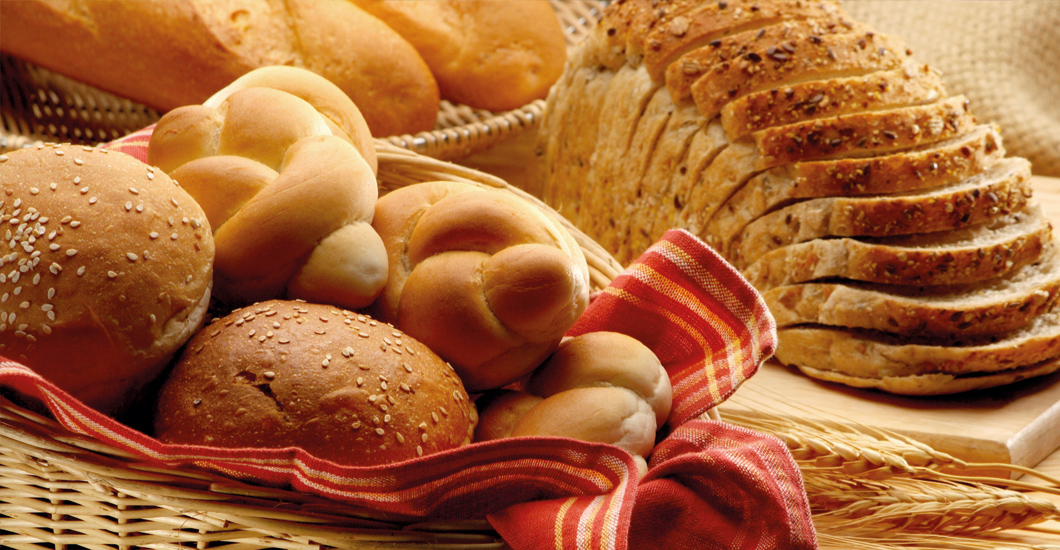Bread is an age-old staple for humankind. It is also a symbol, a message, and an icon. You can’t miss it on tables worldwide in its many variations. Let's take a look at some of the most common breads.
1. RYE BREAD
Rye bread is rich in vitamins E and B, and in minerals like potassium, magnesium, phosphorous, and zinc. It contains lysine, an amino acid that helps in the production of collagen. For this reason, rye bread is recommended as a means to strengthen bone mass and to help prevent cartilage deterioration in joints. Rye bread contains a large amount of fiber, which improves intestinal transit, makes you feel full, and decreases sugar absorption—an added benefit for diabetics.
2 slices of rye bread contain:
- Calories: 263
- Protein: 10.8 grams
- Fat: 1.2 grams
- Carbohydrates: 52 grams
2. WHOLE WHEAT BREAD
Bread quality varies based on the processes that the flour undergoes. When the grain is completely ground with its husk, a brown or whole wheat bread is the result, which provides three times the amount of fiber as white bread or bread made with refined wheat flour. The benefits of whole wheat bread are that it makes you feel fuller than white bread (since it is more dense), it favors motility, and is absorbed more slowly, which regulates the amount of sugar in the blood.
2 slices of whole wheat bread contain:
- Calories: 140
- Protein: 6 grams
- Fat: 2.5 grams
- Carbohydrates: 23 grams
3. MULTIGRAIN BREAD
Breads that contain, in addition to wheat, seeds like linseed, sesame, sunflower, quinoa, and pumpkin seeds, provide much more fiber, minerals, and vitamins than other breads—however, these breads also have more calories. These breads are ideal for athletes or for those people who suffer from constipation. They also strengthen the immune system and help to prevent certain types of cancer and cardiovascular problems since they contain omega-3 fatty acids along with many other nutrients.
2 slices of multigrain bread contain:
- Calories: 150
- Protein: 5 grams
- Fat: 2 grams
- Carbohydrates: 27 grams
4. OAT BREAD
Oats are the most complete grain since they contain protein, carbohydrates, sodium, potassium, calcium, phosphorous, copper, zinc, B-complex vitamins, vitamin E, and unsaturated fats. In addition, oats are a grain full of soluble and insoluble fiber, which helps to prevent constipation and digestive discomfort. Since it has 65% unsaturated fat and 35% linoleic acid (an essential fatty acid that belongs to the omega-6 family), it helps to reduce bad cholesterol (LDL) and triglycerides.
2 slices of oat bread contain:
- Calories: 146
- Protein: 4.4 grams
- Fat: 2.2 grams
- Carbohydrates: 26 grams
5. BARLEY BREAD
Barley contains hordein, a substance that acts like an intestinal antiseptic and helps in cases of infectious diarrhea. Barley also has another substance known as inositol, which regulates cholesterol, avoids the accumulation of fat in the liver, and protects the nervous system. People who want to lose weight perhaps are not particularly encouraged to eat barley bread since barley contains a few more calories than other grains, seeds, or cereals.
100 grams of barley bread contain:
- Calories: 295
- Protein: 7.2 grams
- Fat: 0.2 grams
- Carbohydrates: 66.2 grams
6. CORN BREAD
Corn bread contains carbohydrates and provides vitamins A, C, and E, as well as B-complex vitamins. It has double the amount of polyunsaturated fats (the good kind) than wheat or barley, although not as much as oat bread. It’s important to know that corn bread contains iodine, which is not found in many foods, but is vital for proper functioning of the thyroid gland. Iodine helps synthesize cholesterol, makes nerves and muscles work more effectively, and keeps nails, hair, teeth, and skin healthy.
100 grams of corn bread contain:
- Calories: 299
- Protein: 7.2 grams
- Fat: 10 grams
- Carbohydrates: 48.1 grams
7. WHITE BREAD
Contrary to popular belief, white bread does not contribute to weight gain when it is part of a balanced diet, since it does not have many calories and is cholesterol-free. White bread is an excellent option to meet the nutritional recommendations of 60% of daily caloric intake coming from cereals (flours). Although the husk is removed during the milling process, white bread still manages to provide 3.5 grams of fiber for every 100 grams.
2 slices of white bread contain:
- Calories: 140
- Protein: 4 grams
- Fat: 2 grams
- Carbohydrates: 28 grams



